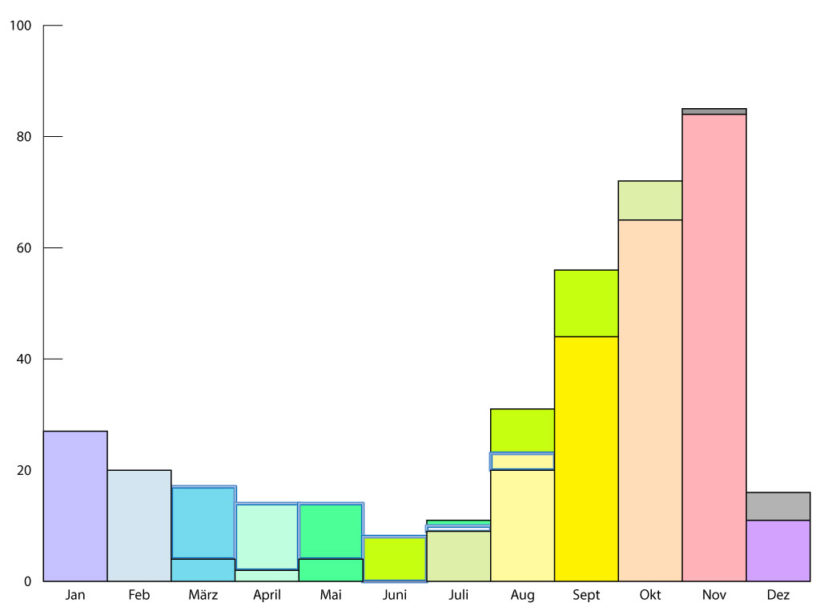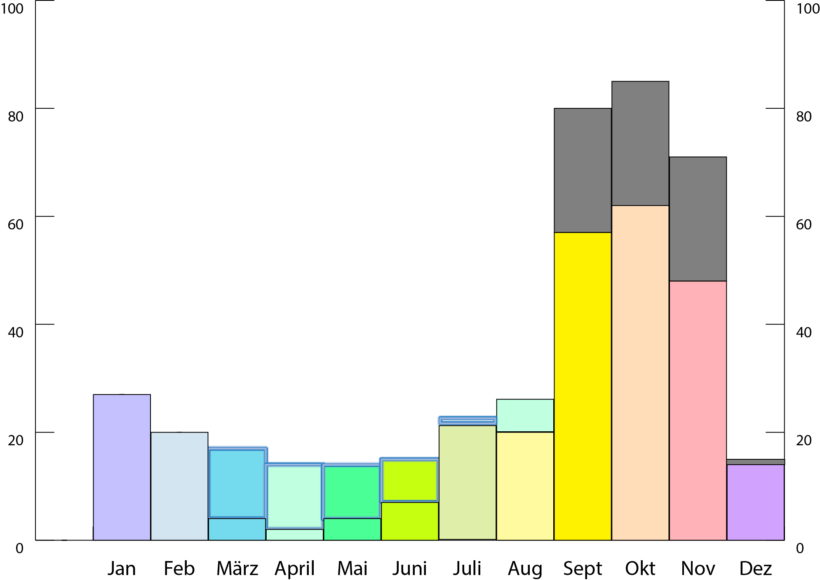
Diagram: Distribution of the number of announced festival dates over the year 2020 (as per 1.6.20, data basis: own festival calendar). Raised columns=new dates (the colour refers to the originally planned month), grey= moved without a fixed date
A month has passed since I reported for the second time on the reactions of film festivals to cinema closures – time to take another look at the situation.
Cinemas are reopening in many European countries. This gives hope to festivals, even though the associated requirements are not exactly inviting. This is because the distance regulations mean that only a minimum of the seating capacity can be used in halls with fixed seating.
On other continents, cinemas are expected to reopen first in Australia and New Zealand. The American continent presents a mixed pessimistic picture. In Canada the discussion about reopenings is just beginning. In the USA, July is targeted as the opening date in some states. Meanwhile, the largest American cinema chain, AMC, has announced that there is great concern about whether it will be able to survive the crisis at all.
In many South American countries, the regulations are being reduced in spite of the waves of infection.
In India, the government announced the first phase of easing at the beginning of June. Cinemas are not included and will only be involved in phase 3. In China, 500 cinemas were temporarily open in March, but were closed again indefinitely after low attendance and a resurgence of infections. In some East Asian countries, partly also in Japan, the cinemas are reopened under certain conditions or have never been closed (Singapore). Due to the lack of current film releases, classics and older blockbusters are shown. Festival screenings would actually come in very handy in this situation.
The plans for international film festivals are correspondingly geographically diverse. Some festivals in Europe, especially in the Mediterranean, South America and Australia hope to be taking place in late summer and autumn, and in the southern hemisphere in spring.
Monthly comparison
The figures below show the announced festival dates in monthly steps. Diagram 1 shows festivals as they were planned a month ago. In diagram 2 I entered the current distribution of the announced dates as of June 1. Here is a better comparison of the two diagrams:

Diagram: Status 1.5.2020 (Proportion of online festivals = blue frames)

Diagram: Distribution of the number of announced festival dates over the year 2020 (as per 1.6.20, data basis: own festival calendar). Raised columns=new dates (the colour refers to the originally planned month), grey= moved without a fixed date
In comparison, it is clearly visible how online presentations were added to the few festivals that stuck to their dates in the second quarter and were generally unable to take place. Among them are also some festivals that changed their mind and instead of cancelling or postponing the date decided to go online.
One can also see how further cancellations in early summer lead to a strong increase in late autumn.
Online festival offers

Online editions of festivals that could not take place.
This diagram shows the time distribution of the festivals that have appeared online and are still planning to do so. Only those festivals that cannot take place due to the pandemic are taken into account. Not included here are the many festivals that have always made additional online offers and plan to continue to do so in the coming months.
As predicted last month, the number of online editions is falling rapidly over time and will already reach zero in September. But, as before, the question arises whether the organizers are not too optimistic about the future and whether the schedule will have to be adjusted again later.
Part 1 from April 2, 2020: Waiting for the wave – Film festivals between shutdown and hope
Part 2 from May 5, 2020: Waiting for the wave 2 – film festivals between shutdown and hope
1 Trackback